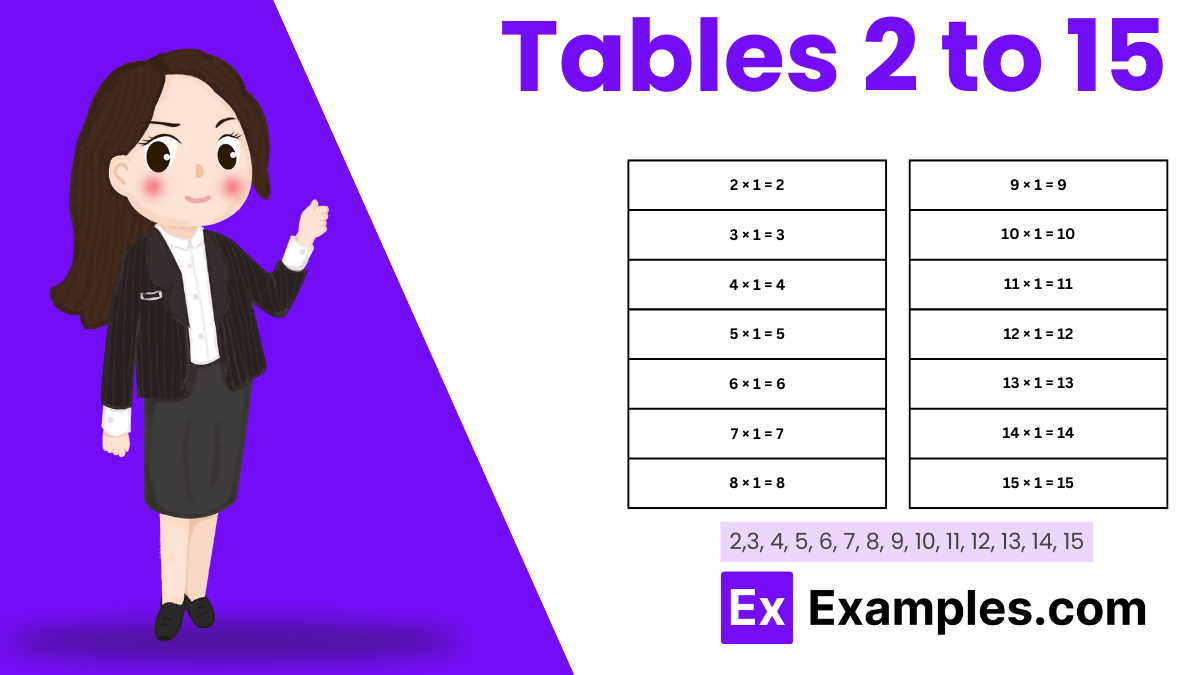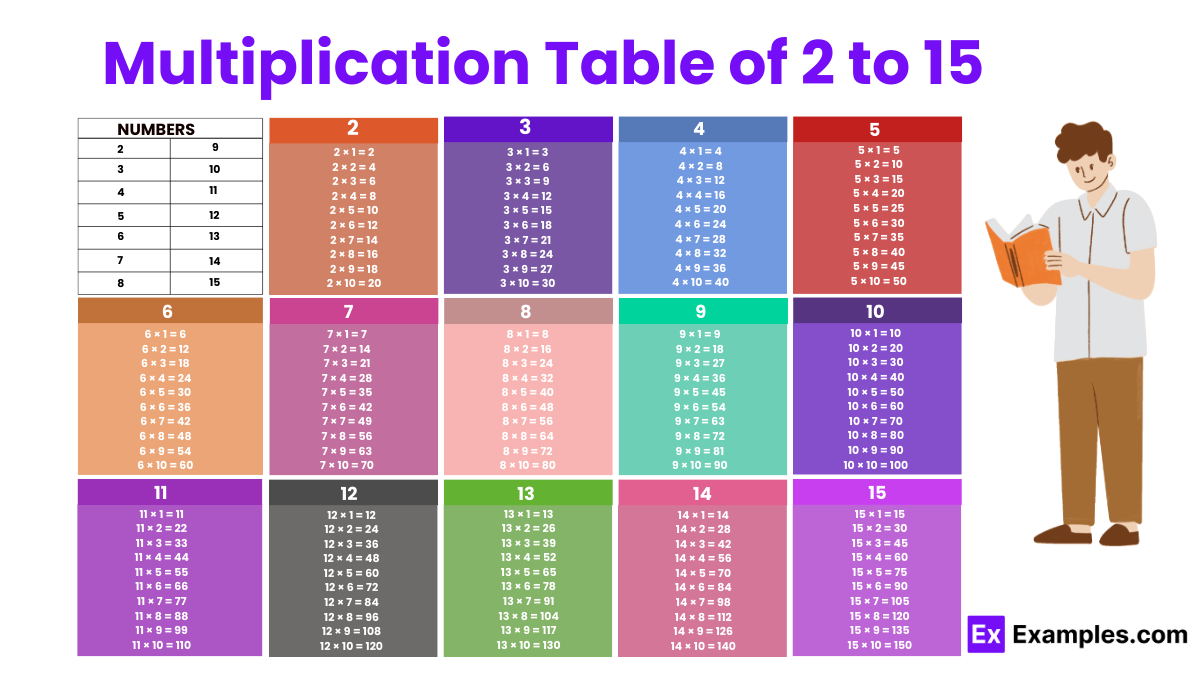What is the product of 7 and 8?
54
56
58
60


Explore a detailed multiplication chart covering tables 2 to 15, designed to strengthen math skills for students and educators. This resource includes helpful tricks and tips for efficient learning and retention, ideal for academic enhancement.

Download Tables From 2 to 15 Chart Pdf
The multiplication tables from 2 to 15 are foundational elements in any mathematics curriculum, crucial for developing early arithmetic skills and confidence in handling numbers. This range encompasses the basic tables typically taught in elementary school, extending into more complex products that are essential for middle school mathematics. A comprehensive chart of these tables provides a visual aid that helps students understand and memorize the relationships between numbers, making it easier to perform calculations for multiplication, division, and beyond. Such charts are indispensable in classrooms and for home study, supporting consistent practice and reinforcement of key math concepts.
Download Tables From 2 to 15 Chart Pdf
| Tables 2 to 15 | Table 2 | Table 3 | Table 4 | Table 5 |
| Table 6 | Table 7 | Table 8 | Table 9 | Table 10 |
| Table 11 | Table 12 | Table 13 | Table 14 | Table 15 |
| 2 Table | 3 Table | 4 Table | 5 Table | 6 Table |
|---|---|---|---|---|
| 2 × 1 = 2 | 3 × 1 = 3 | 4 × 1 = 4 | 5 × 1 = 5 | 6 × 1 = 6 |
| 2 × 2 = 4 | 3 × 2 = 6 | 4 × 2 = 8 | 5 × 2 = 10 | 6 × 2 = 12 |
| 2 × 3 = 6 | 3 × 3 = 9 | 4 × 3 = 12 | 5 × 3 = 15 | 6 × 3 = 18 |
| 2 × 4 = 8 | 3 × 4 = 12 | 4 × 4 = 16 | 5 × 4 = 20 | 6 × 4 = 24 |
| 2 × 5 = 10 | 3 × 5 = 15 | 4 × 5 = 20 | 5 × 5 = 25 | 6 × 5 = 30 |
| 2 × 6 = 12 | 3 × 6 = 18 | 4 × 6 = 24 | 5 × 6 = 30 | 6 × 6 = 36 |
| 2 × 7 = 14 | 3 × 7 = 21 | 4 × 7 = 28 | 5 × 7 = 35 | 6 × 7 = 42 |
| 2 × 8 = 16 | 3 × 8 = 24 | 4 × 8 = 32 | 5 × 8 = 40 | 6 × 8 = 48 |
| 2 × 9 = 18 | 3 × 9 = 27 | 4 × 9 = 36 | 5 × 9 = 45 | 6 × 9 = 54 |
| 2 × 10 = 20 | 3 × 10 = 30 | 4 × 10 = 40 | 5 × 10 = 50 | 6 × 10 = 60 |
| 7 Table | 8 Table | 9 Table | 10 Table | 11 Table |
|---|---|---|---|---|
| 7 × 1 = 7 | 8 × 1 = 8 | 9 × 1 = 9 | 10 × 1 = 10 | 11 × 1 = 11 |
| 7 × 2 = 14 | 8 × 2 = 16 | 9 × 2 = 18 | 10 × 2 = 20 | 11 × 2 = 22 |
| 7 × 3 = 21 | 8 × 3 = 24 | 9 × 3 = 27 | 10 × 3 = 30 | 11 × 3 = 33 |
| 7 × 4 = 28 | 8 × 4 = 32 | 9 × 4 = 36 | 10 × 4 = 40 | 11 × 4 = 44 |
| 7 × 5 = 35 | 8 × 5 = 40 | 9 × 5 = 45 | 10 × 5 = 50 | 11 × 5 = 55 |
| 7 × 6 = 42 | 8 × 6 = 48 | 9 × 6 = 54 | 10 × 6 = 60 | 11 × 6 = 66 |
| 7 × 7 = 49 | 8 × 7 = 56 | 9 × 7 = 63 | 10 × 7 = 70 | 11 × 7 = 77 |
| 7 × 8 = 56 | 8 × 8 = 64 | 9 × 8 = 72 | 10 × 8 = 80 | 11 × 8 = 88 |
| 7 × 9 = 63 | 8 × 9 = 72 | 9 × 9 = 81 | 10 × 9 = 90 | 11 × 9 = 99 |
| 7 × 10 = 70 | 8 × 10 = 80 | 9 × 10 = 90 | 10 × 10 = 100 | 11 × 10 = 110 |
| 12 Table | 13 Table | 14 Table | 15 Table |
|---|---|---|---|
| 12 × 1 = 12 | 13 × 1 = 13 | 14 × 1 = 14 | 15 × 1 = 15 |
| 12 × 2 = 24 | 13 × 2 = 26 | 14 × 2 = 28 | 15 × 2 = 30 |
| 12 × 3 = 36 | 13 × 3 = 39 | 14 × 3 = 42 | 15 × 3 = 45 |
| 12 × 4 = 48 | 13 × 4 = 52 | 14 × 4 = 56 | 15 × 4 = 60 |
| 12 × 5 = 60 | 13 × 5 = 65 | 14 × 5 = 70 | 15 × 5 = 75 |
| 12 × 6 = 72 | 13 × 6 = 78 | 14 × 6 = 84 | 15 × 6 = 90 |
| 12 × 7 = 84 | 13 × 7 = 91 | 14 × 7 = 98 | 15 × 7 = 105 |
| 12 × 8 = 96 | 13 × 8 = 104 | 14 × 8 = 112 | 15 × 8 = 120 |
| 12 × 9 = 108 | 13 × 9 = 117 | 14 × 9 = 126 | 15 × 9 = 135 |
| 12 × 10 = 120 | 13 × 10 = 130 | 14 × 10 = 140 | 15 × 10 = 150 |
Example 1: Table of 2
Problem: 2 x 9 = ?
Solution: 2 x 9 = 18 (Two times nine equals eighteen.)
Example 2: Table of 3
Problem: 3 x 5 = ?
Solution: 3 x 5 = 15 (Three multiplied by five results in fifteen.)
Example 3: Table of 4
Problem: 4 x 7 = ?
Solution: 4 x 7 = 28 (Four times seven yields twenty-eight.)
Example 4: Table of 5
Problem: 5 x 8 = ?
Solution: 5 x 8 = 40 (Five multiplied by eight equals forty.)
Example 5: Table of 6
Problem: 6 x 10 = ?
Solution: 6 x 10 = 60 (Six times ten results in sixty.)
Example 6: Table of 7
Problem: 7 x 6 = ?
Solution: 7 x 6 = 42 (Seven times six equals forty-two.)
Example 7: Table of 8
Problem: 8 x 4 = ?
Solution: 8 x 4 = 32 (Eight times four yields thirty-two.)
Example 8: Table of 9
Problem: 9 x 3 = ?
Solution: 9 x 3 = 27 (Nine multiplied by three results in twenty-seven.)
Example 9: Table of 10
Problem: 10 x 5 = ?
Solution: 10 x 5 = 50 (Ten times five equals fifty.)
Example 10: Table of 11
Problem: 11 x 7 = ?
Solution: 11 x 7 = 77 (Eleven times seven yields seventy-seven.)
Learning the multiplication tables is essential because it forms the foundation for various mathematical concepts and skills. Mastery of multiplication tables enables students to perform calculations quickly and accurately, which is crucial in everyday life and academic pursuits.
Children typically start learning the multiplication tables around the ages of 7 to 9, depending on their individual readiness and the curriculum of their educational system. However, some children may begin learning multiplication concepts earlier through informal activities and games.
Effective strategies for learning the multiplication tables include using visual aids such as multiplication charts and arrays, practicing skip counting, using mnemonic devices or memory aids, incorporating games and interactive activities, providing regular practice and review opportunities, and relating multiplication to real-life situations.
If your child is having difficulty learning the multiplication tables, try breaking down the multiplication facts into smaller, more manageable sets, providing additional practice and review opportunities, offering different learning resources and approaches, seeking help from their teacher or a tutor if needed, and providing plenty of encouragement and support.
The time it takes for children to learn the multiplication tables varies depending on factors such as their age, prior mathematical knowledge, learning style, and the amount of practice and support they receive. With consistent practice and effective instruction, most children can master the multiplication tables within a few months to a year.
Text prompt
Add Tone
10 Examples of Public speaking
20 Examples of Gas lighting
What is the product of 7 and 8?
54
56
58
60
Calculate 12 × 5 using the distributive property.
50
55
60
65
What is 9 times 6 using repeated addition?
52
53
54
55
Find the result of 8 × 9 using the commutative property.
70
72
74
76
What is 6 × 11?
64
66
68
70
Calculate 15 × 3 by breaking it down.
40
42
45
48
What is 14 × 2 using the distributive property?
26
28
30
32
What is 2 × 15?
28
30
32
34
Find the result of 9 × 7 using the commutative property.
63
66
68
92
What is the product of 10 and 8?
80
84
88
90
Before you leave, take our quick quiz to enhance your learning!

